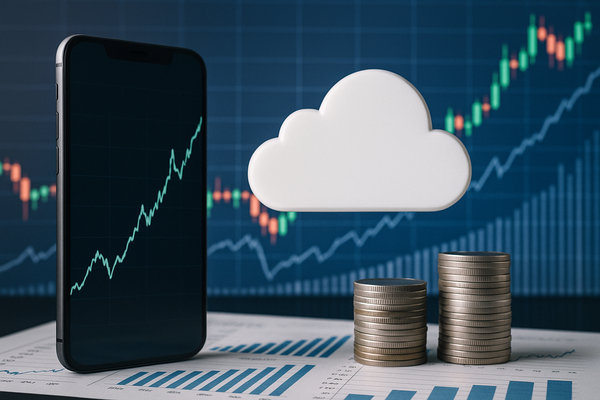
Apple and AI cloud deals reshape market momentum. Apple Inc. (NASDAQ:AAPL) is reporting continued strength in the iPhone 17 base model while a string of multibillion-dollar AI infrastructure pacts is redirecting capital toward cloud and chip suppliers. In the short term, Amazon’s (NASDAQ:AMZN) $38 billion OpenAI agreement and Microsoft’s (NASDAQ:MSFT) $9.7 billion deal with IREN are fuelling rallies in AI supply chains and Nvidia (NASDAQ:NVDA)-linked stocks. Over the long term, these contracts deepen hyperscalers’ compute commitments, benefit chipmakers and cloud platforms globally, and raise strategic questions for consumer tech names like Apple about AI positioning and monetization.
Market reaction: AI cloud contracts electrify chip and cloud stocks
Monday’s session made the point starkly. OpenAI signed a seven-year agreement to buy roughly $38 billion of services from Amazon Web Services. The announcement sent Amazon shares higher and helped narrow leadership toward AI infrastructure providers. Meanwhile, Microsoft secured a separate $9.7 billion commitment with IREN for Nvidia-powered AI capacity — a trade that highlights how hyperscalers are prepaying to lock scarce GB300-class GPUs. The Dow slipped roughly 410 points (about 0.9%) even as AI-linked names outperformed.
These deals are already shifting revenue expectations for ecosystem players. Broadcom (NASDAQ:AVGO) and Nvidia (NASDAQ:NVDA) sit at the center of that flow. Broadcom has seen **year-to-date gains near 59%**, while Nvidia remains the market’s focal point after topping $5 trillion in market capitalization in recent weeks. Services and hardware firms from Dell and Lambda to smaller AI infrastructure vendors are reporting immediate demand tailwinds.
Short-term impact: clear re-rating of firms tied to GPU supply, data-center hosts and cloud services. Long-term impact: contracts like these create multi-year revenue visibility for hyperscalers and chip suppliers, and intensify competition for capacity across US, Europe and Asia supply chains.
Apple’s product strength vs. the unanswered AI playbook
Apple (NASDAQ:AAPL) continues to report robust consumer demand. Jefferies flagged the iPhone 17 base model as the standout in Apple’s latest lineup, showing the “most consistent strength” across major markets. The product cycle is delivering near-term revenue support; Apple shares have rebounded sharply from earlier lows, up roughly 64% since April in some reports.
However, public commentary from market participants highlights an open question about how Apple will convert device leadership into AI platform leadership. CNBC commentator Josh Brown and others have flagged Apple’s AI strategy as the biggest open question following the Microsoft-OpenAI and Amazon-OpenAI moves. Technical commentary has also surfaced: some analysts cite **$260** as critical resistance for the stock according to market technicians.
Complicating the narrative, Berkshire Hathaway’s (NYSE:BRK.B) portfolio action added a market signal: Warren Buffett sold roughly 20 million shares of his top holding in Q2, a transaction reported at about $4.1 billion. That trade is drawing headlines because Berkshire remains concentrated — roughly 60% of its portfolio is in four stocks — and such a sale roils investor attention on whether large, passive or concentrated owners will rebalance tech exposure.
Bottom line: Apple’s hardware momentum is real and measurable this quarter, but investors and competitors are accelerating cloud and chip bets that define the wider AI ecosystem.
Earnings and corporate signals: winners, margins and supply-chain moves
Earnings season and corporate releases reinforce the bifurcation. Palantir (NASDAQ:PLTR) posted a strong Q3 with revenue growth above 60% year-over-year and raised its full-year adjusted free cash flow targets to roughly $1.9 billion–$2.1 billion, underscoring the commercial demand for AI analytics. On the semiconductor front, ON Semiconductor (NASDAQ:ON) beat Q3 estimates with revenue of $1,550.9 million and non-GAAP EPS of $0.63; the company highlighted AI-driven demand for power-management chips in data centers.
Memory and wafer-equipment names also moved. Micron (NASDAQ:MU) enjoyed analyst upgrades after bullish checks at South Korean peers and spot DDR5 pricing surges. Lam Research (NASDAQ:LRCX) has already climbed more than **117% year-to-date**, reflecting investor expectations for strong capex in advanced node manufacturing. At the same time, Adeia’s patent litigation against AMD (NASDAQ:AMD) and other legal actions show the sector’s IP tensions as firms chase performance edges.
Cloud and security tie-ins matter too. CrowdStrike (NASDAQ:CRWD) expanded a global cybersecurity accelerator with AWS and NVIDIA to support AI-driven startups. Snowflake (NYSE:SNOW) continues to ink cloud partnerships and has climbed roughly **74.5% year-to-date**, illustrating demand for data platforms that can stitch enterprise data to generative models.
Key takeaways:
- AI cloud contracts are creating multi-year revenue backlogs for hyperscalers and GPU suppliers.
- Apple’s (NASDAQ:AAPL) handset strength provides near-term support, but questions about its AI platform strategy remain.
- Watch chip supply chains and memory pricing: they are central to which vendors benefit next.
- Corporate actions — from Berkshire’s share sales to Palantir’s raised FCF targets ($1.9bn–$2.1bn) — are shifting narrative and capital flows.
The combination of consumer product resilience at Apple and sweeping cloud compute commitments from Amazon and Microsoft is reshaping where investors look for durable AI revenue. Near-term wins favor cloud hosts, chip vendors and data-platform specialists. Over time, companies that link devices, software and cloud AI services will have the clearest runway to convert demand into predictable streams — a process that will play out differently across the US, Europe and Asian markets.












